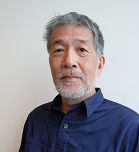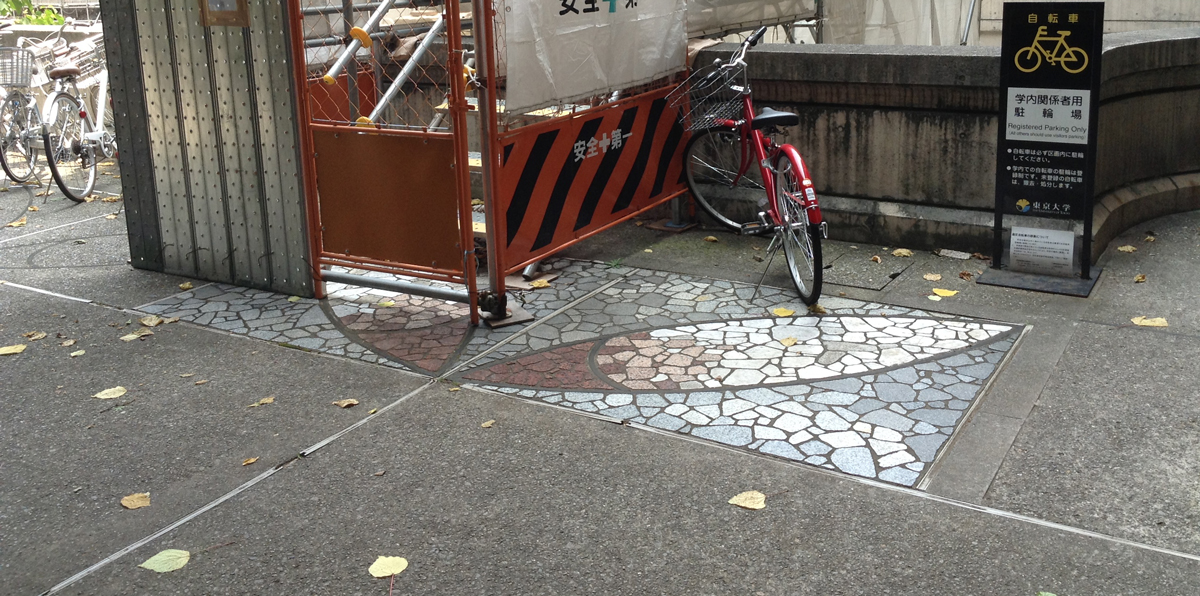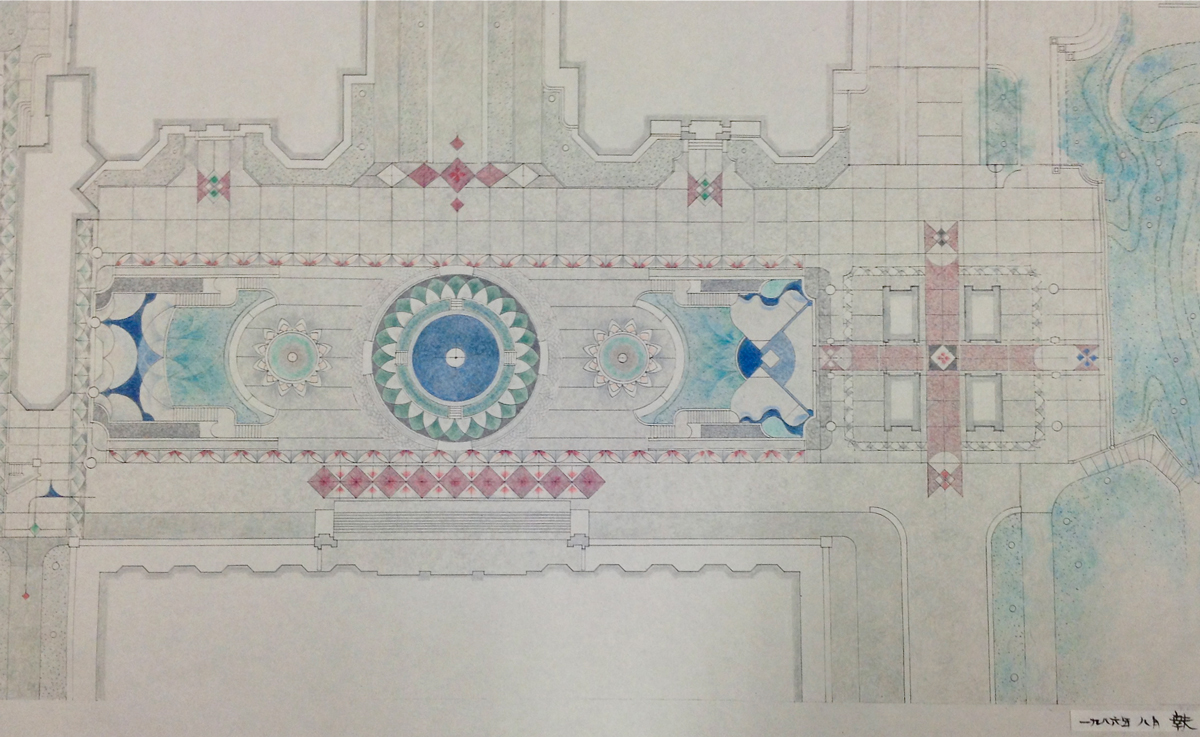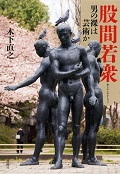What We Can Learn from the Mosaics Underfoot in the Plaza in Front of the Library

Naoyuki Kinoshita
Professor
Graduate School of Humanities and Sociology
Professor Kinoshita explores a smorgasbord of topics with abandon. Starting with art history, his interests seem just about endless―emado (places where prayer tablets are hung in shrines), festivals, misemono (shows and performances), exhibitions, monuments, zoos, castles, erotica, statues of nude males... By taking a good look at the patterns “underfoot” that are fading from our memory, he quietly, yet dauntlessly, tells of one defining characteristic of the human condition, as well as the importance of the Faculty of Letters, which continuously considers such things.
I started a class called “Exploring the University of Tokyo” in the Faculty of Letters. This series of lectures, held in cooperation with the University’s Archeological Research Unit, invites professors from various areas of the University, such as the School of Engineering, the School of Science, the Historiographical Institute, the Institute of Industrial Science, the University Museum and the University Archives to give talks one after another in a relay fashion. Scores of students from throughout the University have been drawn to this class in response to the syllabus, which reads: “Most UTokyo students will graduate without ever actually knowing their university. That’s a bit of a waste.”

Having been the location of the main residence of the Kaga Domain during the Edo period, the Hongo Campus of UTokyo is indeed a place worth exploring. The true meaning of “waste” in the syllabus, however, came from my wish for us to know where we actually are. What this class is asking students to do, in other words, is to start looking at where they are standing from the ground up.
Accordingly, the theme of the class is not limited to the University. Even after they graduate, I hope the students will keep on questioning where they really are. If allowed to be a bit boastful, I believe the Faculty of Letters is a place where this question will be continuously, if not eternally, asked from numerous points of view.
Let me introduce just one example of something “underfoot” that I presented in this year’s class. It is literally something that lies under our feet; a mosaic on the “ground” that we walk over without giving a second thought. Yet once we stop, think, and wonder why this mosaic was created, we realize that someone’s intentions are behind it all. Going one step further to try to understand what those intentions were―that is the start of exploration.
Accordingly, the theme of the class is not limited to the University. Even after they graduate, I hope the students will keep on questioning where they really are. If allowed to be a bit boastful, I believe the Faculty of Letters is a place where this question will be continuously, if not eternally, asked from numerous points of view.
Let me introduce just one example of something “underfoot” that I presented in this year’s class. It is literally something that lies under our feet; a mosaic on the “ground” that we walk over without giving a second thought. Yet once we stop, think, and wonder why this mosaic was created, we realize that someone’s intentions are behind it all. Going one step further to try to understand what those intentions were―that is the start of exploration.

Looking upward, you will see a figure drawn by architect Yukio Otani titled Plaza Mandala (Hiroba no Mandala; 1986). Otani explains this mandala in his book: “I wanted to welcome the spirits of my superiors and colleagues who died in World War II with the Kurin Pond in the center and the camphor trees to the right and left of the plaza.” (1)
As one can infer from his words, Otani, who also designed the No. 3 building of the Faculty of Letters and the No. 4 building of the Faculty of Law, wanted the plaza in front of the Library to be a place to commemorate people who died in the war. Otani graduated from the University of Tokyo’s Faculty of Engineering in 1946; he was in the generation that was slightly younger than those who went to war under the student mobilization order. The mosaic in the picture is a part of Plaza Mandala.
Otani’s wish of “welcoming the dead” conveys the feeling that they had not been welcomed. However, that is certainly not to say that they had been forgotten until Otani created the Plaza Mandala. I say this because in September 1941, the War Memorial Room was established in the Library. Then-President Yuzuru Hiraga declared, “let us sanctify our University’s brave and honorable war dead and eternally preserve the record of their loyalty as a model for generations to come,” (2) and built an altar in a corner of what is now the Western Journal Reading Room. (3) In October of the same year, a Memorial Service For the Workers and Students of Tokyo Imperial University Killed in the China Incident (4), and in October 1943, a Memorial Service for the Workers and Students of Tokyo Imperial University Killed in the Great East Asia War (5) were held. Memorial services for war dead at the University of Tokyo date back to the time of the Russo-Japanese War; those also took place in (a former building of) the Library.
We humans can easily forget such things. (6) If, then, the purpose of the Faculty of Letters is to resurrect these memories in order to persistently remind us of our shared humanity, there can be nothing of greater service to society.
Question: Is your research useful?
Answer: Just as with the Faculty of Medicine, I think that the Faculty of Letters has a human side that can’t simply be compartmentalized into the “sciences” or “humanities” categories. And besides that, I do not find this question to be significant either in meaning or expression.
(We have asked twelve professors who contributed articles to this issue to answer the above question in 60 words or fewer. Professor Kinoshita's response appears here.)
As one can infer from his words, Otani, who also designed the No. 3 building of the Faculty of Letters and the No. 4 building of the Faculty of Law, wanted the plaza in front of the Library to be a place to commemorate people who died in the war. Otani graduated from the University of Tokyo’s Faculty of Engineering in 1946; he was in the generation that was slightly younger than those who went to war under the student mobilization order. The mosaic in the picture is a part of Plaza Mandala.
Otani’s wish of “welcoming the dead” conveys the feeling that they had not been welcomed. However, that is certainly not to say that they had been forgotten until Otani created the Plaza Mandala. I say this because in September 1941, the War Memorial Room was established in the Library. Then-President Yuzuru Hiraga declared, “let us sanctify our University’s brave and honorable war dead and eternally preserve the record of their loyalty as a model for generations to come,” (2) and built an altar in a corner of what is now the Western Journal Reading Room. (3) In October of the same year, a Memorial Service For the Workers and Students of Tokyo Imperial University Killed in the China Incident (4), and in October 1943, a Memorial Service for the Workers and Students of Tokyo Imperial University Killed in the Great East Asia War (5) were held. Memorial services for war dead at the University of Tokyo date back to the time of the Russo-Japanese War; those also took place in (a former building of) the Library.
We humans can easily forget such things. (6) If, then, the purpose of the Faculty of Letters is to resurrect these memories in order to persistently remind us of our shared humanity, there can be nothing of greater service to society.
Question: Is your research useful?
Answer: Just as with the Faculty of Medicine, I think that the Faculty of Letters has a human side that can’t simply be compartmentalized into the “sciences” or “humanities” categories. And besides that, I do not find this question to be significant either in meaning or expression.
(We have asked twelve professors who contributed articles to this issue to answer the above question in 60 words or fewer. Professor Kinoshita's response appears here.)
References
1. Urban Things―A Collection of Works by Yukio Otani (Toshiteki Narumono―Otani Yukio Sakuhin Shu) (Kenchiku Shiryo Kenkyusha CO., LTD, 2006)
2. Imperial University Press, April 14, 1941
3. Imperial University Press, September 22, 1941
4. Matters on Memorial Services for the Dead from the China Incident (Shina Jihen Senbotsusha Irei Sai Kankei), booklet owned by the University of Tokyo Archives
5. Imperial University Press, October 25, 1943
6. Refer to my piece Place Where the Dead Are Revived (Shisha ga Yomigaeru Basho) (collected in Humanities II Dialogue with the Dead published by University of Tokyo Press, Kan Nozaki and Akira Akiyama, ed., 2014)
* This article was originally printed in Tansei 33 (Japanese language only).
2. Imperial University Press, April 14, 1941
3. Imperial University Press, September 22, 1941
4. Matters on Memorial Services for the Dead from the China Incident (Shina Jihen Senbotsusha Irei Sai Kankei), booklet owned by the University of Tokyo Archives
5. Imperial University Press, October 25, 1943
6. Refer to my piece Place Where the Dead Are Revived (Shisha ga Yomigaeru Basho) (collected in Humanities II Dialogue with the Dead published by University of Tokyo Press, Kan Nozaki and Akira Akiyama, ed., 2014)
* This article was originally printed in Tansei 33 (Japanese language only).








